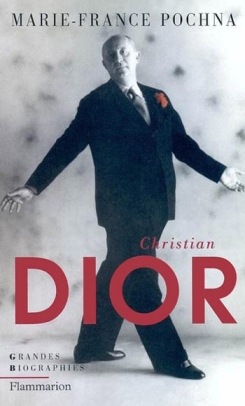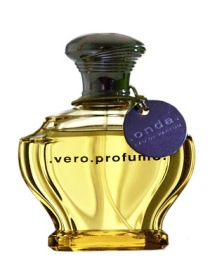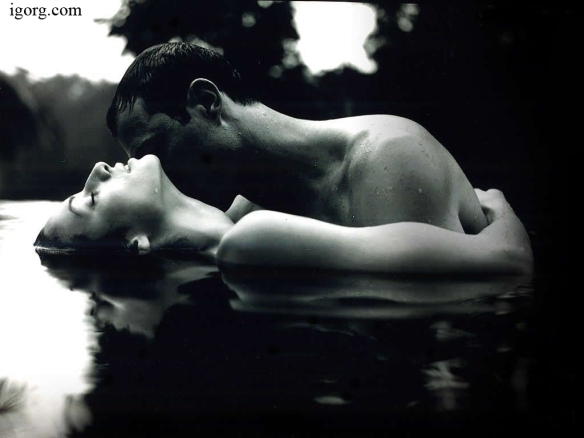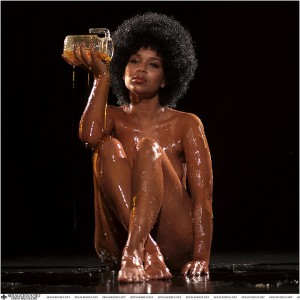At the heart of a vetiver forest, there is a campfire whose smoke swirls into air made crisp with a hint of red apples and dark with flecks of black leather. It’s a forest named after the king, or Konig, and it is the latest creation from the San Francisco perfumer, Yosh.
Konig is an eau de parfum released in 2013 and created by Yosh’s founder and nose, Yosh Han. Her website describes the perfume and its inspiration as follows:
An homage to the king within, perfumer Yosh Han, introduces KÖNIG, a dark charismatic elixir fit for royals of yesterday and mortals of today. KÖNIG takes us to a deep, black Bavarian forest during the time of medieval kings.
This elegant masculine scent captures the dual nature of man – gentleman and hunter, an alpine fragrance that evokes a king on a hunt, racing through the Bavarian forest with aromatic bitters and crisp red apples in the air. Beneath a layer of snow flowers, it opens into a white musc and deepens into the scent of saddle leather and smoky firewood.
[Notes:] Aromatic bitters, sage, cypress, apple, smoky papyrus, snow flowers, bois d’landes, vetiver, white musc, saddle leather, amber, firewood
Fragrantica gives the following perfume pyramid:
Top notes are sage and cypress; middle notes are red apple, papyrus, snowdrops and woody notes; base notes are vetiver, white musk, leather, amber and woody notes.
In case you’re wondering, “snowdrops” are not clumps of snow. According to Fragrantica, they are very pretty white flowers (Galanthus nivalis) that have a cool, fresh, floral note. As for “Bois d’landes,” I’m afraid I have no clue what that might be, and my Google searches turned up nothing.
Konig opens on my skin with smoky vetiver, cedar, smoke, papyrus, and tinges of apple. It is a thin, sheer, light, but potent bouquet really centered around smoky vetiver with the campfire smoke of singed woods. Birch has to be one of the unspecified “woody notes” mentioned on Fragrantica, or perhaps it is that “bois d’landes.” The bouquet is supplemented by a light herbal hint, and a trace of a synthetic “woody amber” note that smells, to me, like Ambermax, though it could be any one of a number of woody-amber aromachemicals on the market. The apple is extremely muffled on my skin, and turns into faint impression of a vaguely fruited sweetness after a few minutes on my skin.
As a whole, Konig feels mostly like a sheer mélange of dark, smoked vetiver and various singed woods, all infused with birch campfire smoke on a base that is lightly flecked by a nebulous sweetness and an amber aromachemical. It has very soft sillage that radiates out about 2 inches with 4 large smears, and only 1 inch with half that amount.
After 5 minutes, the perfume shifts a little. The tiniest flicker of leather appears. It’s a subset of the birch, another aspect separate from that campfire smokiness. It evokes images of black leather, and feels both rubbery and a little bit raw. The woody-amber aromachemical grows stronger, but it never drowns out the smoky vetiver or the birch in the perfume’s opening hour. The ghostly suggestion of apple darts in and out of the dark notes, only occasionally reading as “apple” instead of a nebulous sweet fruit. I don’t detect the snowdrops or anything floral at all.
Konig really doesn’t change much on my skin. At best, the notes rearrange themselves in terms of their order and prominence. The one noticeable difference occurs after the end of the first hour when the vetiver starts to manifest a fresher undertone that is minty, like a touch of bright greenness amidst the dark smokiness. The aromachemical “woody-amber” simply continues to grow stronger, taking on an ISO E Super-like undertone that is a bit antiseptic and like rubbing alcohol on my skin. (It is the main reason why I’m guessing the note is Ambermax, as I’ve experienced that peppered, antiseptic, half-cedar, half-amber, ISO E-like woodiness before in a fragrance that I was informed contained Ambermax.) The sillage hovers just above the skin at the end of the 1st hour, the suggestion of sweetness fades away, and Konig feels even gauzier.
The notes continue to rearrange themselves as time goes on. At the start of the 3rd hour, the birch is now much less prominent, and its lingering traces center on campfire smoke, not leather. The woody-amber note takes over almost completely, and infuses the smoky (but also slightly minty) vetiver from head to toe. The two elements become the main focal point of Konig for the next few hours.
At the start of the 7th hour, Konig feels like a blur of woody-amber that is almost about to vanish. Yet, my skin clings onto aroma-chemicals tenaciously, and Konig is no exception. The drydown is quite pretty, feeling like a slightly smoother, softer coating of amber, without some of the earlier sharpness and medicinal undertones. In its final moments, Konig is a mere suggestion of amber lightly flecked by woodiness. All in all, Konig lasted just short of 10.75 hours on my skin.
There are mixed reviews for Konig out there. On Fragrantica and elsewhere, a lot of people think Konig is like Encre Noire with a touch of apples. I haven’t tried the Lalique fragrance which I know is a vetiver scent with a massive amount of ISO E Super, but I can understand why people might see a connection. Some of the Fragrantica posters write:
- This is Encre Noire with leather. Same Elmer’s glue smell with a super dry woody note. I’m surprised that people see it differently. Longevity is 4 hours, sillage is moderate, replay value also moderate thus making the perfume somewhat forgettable. I have come to the conclusion that Yosh will never top her best creation of Sombre Negra.
- I get a lot of cypress in this. To my nose, it’s basically Encre Noire (current formulation) with apple note. Moderate projection and longevity on my skin.
- On my skin I really like the play between the leather, vetiver and cypress in this. They’re blended in a way that gives a harmonious smokey/dark accord whilst at the same time being easily singled out from each other. After a minute or so the apple, papyrus and sage come through and lay themselves over the leather and woods; lessening the smoke vibe and leaving a faint floral/fruity/woody quality. 30 minutes in and what’s left on my skin is competing notes of dry apples, vetiver and leather.
On Luckyscent, the two comments for Konig both express disappointment over a medicinal aroma:
- Medicinal and balmy, resembling the smell of sterile first aid gauze. Not terrible smelling, but not good at all.
- I agree – highly medicinal at first. Literally smells like a potent band-aid. Once that wears off (takes about an hour on my skin), you’re left with a slightly fruity, leathery skin scent. Eh. Not in love with it.
On Basenotes, there is a whole thread expressing disappointment with Konig. Again, the issue of Encre Noire comes up often. Numerous commentators state that Konig is not bad, but it falls short of expectations. One chap who is actually from Bavaria wrote:
I received a sample and to be honest I am disappointed. I expected something truly outstanding, I mean it’s not bad, but simply not what I expected. […][¶] “König” smells a bit like “Encre Noire” with some apples. The apple-note is not sweet, it’s more like those green and refreshing apples, so it actually adds some coolness and freshness to the scent. It has a nice dry and smoky wood-note, but also like “Encre Noire” this synthetic smelling so-called “White Musk” which I dislike and I think there is also a hefty dose of Iso E Super in it. It has sharper edges than “Encre Noire” and it smells a bit more natural, but is still quite synthetic.
All in all it’s okay but nothing groundbreaking.
The medicinal or ISO E Super-like element is repeated by others in that thread, as well:
- Count me among the disappointed. I am a big Sombre Negre fan and had high hopes. To me there is something like a cypress/Iso E Super accord (reminds me somehow of Terre d’Hermes) laid over burnt wood. I’m fine with weird juxtapositions, but this does not work for me. Also seems weak and short-lived. Took 5 or 6 sprays to the chest and gone within a few hours.
- For me it comes off as medicinal and balmy early, resembling sterilized first aid gauze right out of its pouch. All this with some slightly citric tart apple at the open slowly adding in leathery vetiver-driven woods late. The early developing medicinal aspect just does not work for me at all. Not a good one, IMO.
As regular readers know, I have great problems with aromachemicals, perhaps because my skin amplifies them and makes them last for an eternity. However, even I could manage the one in Konig, as it was hardly as excessive or dominant as other fragrances that I’ve tried. My main difficulty with Konig was something else: I simply don’t enjoy vetiver soliflores. Vetiver is wonderful as one element in a multi-faceted bouquet, but fragrances centered almost purely on the note aren’t really my thing. I also didn’t like Konig’s sheerness and thinness, though I kept thinking that it would be a great summer scent for someone who wants a light vetiver with smokiness.
A lot of the comments quoted above are very fair in their assessment of the fragrance, but I think it’s going to come down to personal tastes. More importantly, I think it’s going to come down to expectations. Konig is simple, straightforward, and uncomplicated, but it’s not a bad scent by any means. The problem seems to be that everyone expected Konig to be as rich, nuanced, and deep as Sombra Negra. It’s not.
If you’re a passionate lover of vetiver fragrances, you may want to give Konig a sniff. If you don’t have strong expectations for a deeply leathered scent, if you don’t anticipate a lot of apples, and if you don’t hope for something analogous to Sombra Negra, then you may enjoy Konig as an easy, campfire, smoky vetiver for very hot months when you don’t want a very heavy fragrance.
Disclosure: Perfume courtesy of Yosh. That did not influence this review, I do not do paid reviews, and my opinions are my own.


































